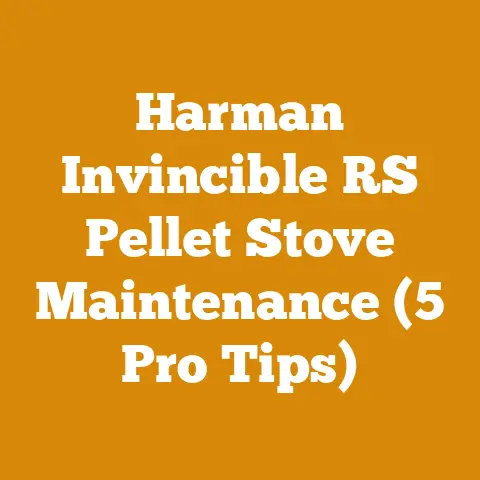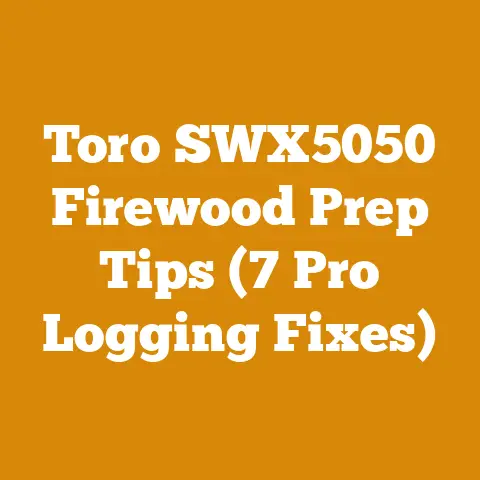Dutch Oven Prime Rib Cooking on a Barrel Stove (Wood-Fired Flavor)
Sometimes, the most rugged, backwoods cooking methods yield the most refined results.
It’s a paradox, isn’t it?
You’d think that a barrel stove, a contraption born from necessity and often found gracing the workshops and hunting cabins of those who appreciate a good fire, would be the last place you’d expect to find a perfectly cooked prime rib.
But trust me, the combination of a Dutch oven, the radiant heat of a barrel stove, and the subtle smokiness imparted by wood-fired cooking can elevate a prime rib to a level you simply can’t achieve in your kitchen oven.
I’ve spent years knee-deep in sawdust, splitting logs, and coaxing warmth from wood stoves.
I’ve learned a thing or two about harnessing the power of wood, not just for heating my home, but for creating culinary masterpieces.
Let me share with you my experience on how to cook a Dutch Oven Prime Rib on a Barrel Stove and impart a wood-fired flavor.
The Allure of Wood-Fired Cooking
There’s something primal about cooking with wood.
It connects us to our ancestors, who relied on fire for survival.
Beyond the romantic appeal, wood-fired cooking offers unique advantages:
- Unmatched Flavor: The subtle smokiness that permeates food cooked over wood is simply unparalleled.
Different wood species impart distinct flavors, allowing you to customize your culinary creations. - Radiant Heat: Wood stoves, especially barrel stoves, excel at producing radiant heat, which cooks food evenly and gently.
This is crucial for achieving a tender, juicy prime rib. - Temperature Control (with practice): While mastering wood-fired cooking takes time, you gain a level of control over temperature that rivals even the most sophisticated ovens.
- Off-Grid Capabilities: In a world increasingly reliant on electricity, wood-fired cooking offers a sustainable and reliable alternative.
Why a Barrel Stove?
Barrel stoves, often constructed from repurposed 55-gallon drums, are a practical and affordable way to harness the power of wood heat.
They offer several advantages for Dutch oven cooking:
- Large Cooking Surface: The flat top of a barrel stove provides ample space for a Dutch oven, even a large one suitable for a prime rib.
- Even Heat Distribution: The radiant heat from the stove’s surface ensures that the Dutch oven is heated evenly, preventing hot spots and ensuring consistent cooking.
- Temperature Regulation: By controlling the airflow to the firebox, you can fine-tune the temperature inside the Dutch oven.
- Portability (relatively): While not exactly lightweight, barrel stoves are relatively portable, allowing you to enjoy wood-fired cooking in your backyard, at a campsite, or even on a hunting trip.
However, they also come with challenges.
Barrel stoves require constant monitoring and adjustment to maintain a consistent temperature.
They also produce smoke, so proper ventilation is essential.
The Heart of the Matter: The Dutch Oven
The Dutch oven is a cast-iron pot with a tight-fitting lid.
Its heavy construction and excellent heat retention make it ideal for slow-cooking and braising, perfect for a prime rib.
- Even Heat Distribution: Cast iron is renowned for its ability to distribute heat evenly, preventing hot spots and ensuring consistent cooking.
- Heat Retention: Dutch ovens retain heat exceptionally well, allowing you to maintain a steady temperature even when the fire fluctuates.
- Versatility: Dutch ovens can be used for a wide range of cooking methods, from baking bread to simmering stews.
- Durability: A well-cared-for Dutch oven can last for generations, becoming a cherished heirloom.
Selecting Your Wood: Flavor Profiles and Considerations
The type of wood you use will significantly impact the flavor of your prime rib.
Here’s a breakdown of popular choices:
- Oak: Oak is a classic choice for smoking, imparting a strong, smoky flavor.
It’s suitable for beef and other hearty meats. - Hickory: Hickory offers a sweeter, more bacon-like flavor than oak.
It’s excellent for pork and ribs, but also works well with beef. - Maple: Maple provides a subtle, sweet, and slightly smoky flavor.
It’s a versatile choice that complements a wide range of foods. - Fruit Woods (Apple, Cherry, Pecan): Fruit woods offer a mild, sweet, and fruity flavor.
They’re ideal for poultry and pork but can also add a unique dimension to beef. - Alder: Alder is a light, slightly sweet wood that imparts a delicate flavor.
It’s often used for smoking salmon and other seafood.
Important Considerations:
- Seasoned Wood: Always use seasoned wood, which has been dried for at least six months.
Green wood produces excessive smoke and doesn’t burn as efficiently. - Avoid Softwoods: Softwoods like pine and fir contain resins that can impart a bitter flavor to your food.
They also tend to burn quickly and produce excessive smoke. - Wood Size: Use wood that is appropriately sized for your barrel stove’s firebox.
Smaller pieces will burn quickly, while larger pieces may not ignite easily. - Quantity: Have plenty of wood on hand, as you’ll need to replenish the fire throughout the cooking process.
My Personal Experience:
I’ve found that a blend of oak and cherry wood provides an excellent balance of smoky and sweet flavors for prime rib.
The oak imparts a robust smokiness, while the cherry adds a subtle sweetness that complements the beef’s richness.
I typically aim for a 70/30 ratio of oak to cherry.
Data Point: Studies have shown that the moisture content of wood significantly affects its burning efficiency and smoke production.
Seasoned wood with a moisture content of 20% or less burns cleaner and produces more heat.
The Recipe: Dutch Oven Prime Rib on a Barrel Stove
This recipe is based on my years of experimentation and offers a reliable method for achieving a perfectly cooked prime rib with a delicious wood-fired flavor.
Ingredients:
- 1 (4-5 pound) bone-in prime rib roast
- 2 tablespoons olive oil
- 2 tablespoons kosher salt
- 1 tablespoon black pepper
- 1 tablespoon garlic powder
- 1 tablespoon onion powder
- 1 teaspoon dried thyme
- 1 teaspoon dried rosemary
- 1 large onion, quartered
- 4 carrots, chopped
- 4 celery stalks, chopped
- 2 cups beef broth
- Wood for the barrel stove (oak, cherry, or a blend)
Equipment:
- Barrel stove
- Dutch oven (6-quart or larger)
- Meat thermometer
- Tongs
- Heat-resistant gloves
- Fire poker
- Axe or hatchet for splitting wood
- Wood moisture meter (optional)
Instructions:
- Prepare the Prime Rib: Remove the prime rib from the refrigerator and let it sit at room temperature for at least two hours.
This allows the meat to cook more evenly.
Pat the prime rib dry with paper towels. - Season the Prime Rib: In a small bowl, combine the olive oil, salt, pepper, garlic powder, onion powder, thyme, and rosemary.
Rub the mixture all over the prime rib, ensuring it’s evenly coated. - Prepare the Vegetables: Place the quartered onion, chopped carrots, and chopped celery stalks in the bottom of the Dutch oven.
These vegetables will create a flavorful base for the prime rib and prevent it from sticking to the bottom of the pot. - Sear the Prime Rib (Optional but Recommended): Heat a cast-iron skillet over medium-high heat.
Sear the prime rib on all sides until it’s nicely browned.
This step adds flavor and helps to seal in the juices.
If your Dutch oven is large enough, you can sear the prime rib directly in the Dutch oven over the barrel stove. - Place the Prime Rib in the Dutch Oven: Place the seared prime rib on top of the vegetables in the Dutch oven.
Pour the beef broth around the prime rib. - Prepare the Barrel Stove: Start a fire in the barrel stove using kindling and small pieces of wood.
Gradually add larger pieces of wood until the fire is burning steadily. - Position the Dutch Oven: Place the Dutch oven on the flat top of the barrel stove.
Ensure that the Dutch oven is centered over the heat source. - Regulate the Temperature: The ideal cooking temperature for a prime rib is around 325°F (163°C).
Monitor the temperature inside the Dutch oven using a meat thermometer.
Adjust the airflow to the firebox to maintain a consistent temperature.
Adding more wood will increase the temperature, while reducing the airflow will lower it. Cook the Prime Rib: Cook the prime rib for approximately 15-20 minutes per pound, or until the internal temperature reaches your desired level of doneness.
Use a meat thermometer to check the internal temperature.- Rare: 120-130°F (49-54°C)
- Medium-Rare: 130-140°F (54-60°C)
- Medium: 140-150°F (60-66°C)
- Medium-Well: 150-160°F (66-71°C)
- Well-Done: 160°F+ (71°C+)
- Rest the Prime Rib: Once the prime rib reaches your desired internal temperature, remove the Dutch oven from the barrel stove.
Carefully remove the prime rib from the Dutch oven and place it on a cutting board.
Tent it loosely with aluminum foil and let it rest for at least 20 minutes before carving.
This allows the juices to redistribute, resulting in a more tender and flavorful roast. - Make the Au Jus (Optional): While the prime rib is resting, you can make an au jus using the pan drippings from the Dutch oven.
Strain the drippings into a saucepan and skim off any excess fat.
Bring the drippings to a simmer over medium heat and cook for a few minutes, or until slightly thickened.
Season with salt and pepper to taste. - Carve and Serve: Carve the prime rib against the grain into thin slices.
Serve with the au jus and your favorite side dishes.
Safety First:
- Always wear heat-resistant gloves when handling the Dutch oven and the barrel stove.
- Keep a fire extinguisher nearby in case of emergencies.
- Ensure that the barrel stove is placed on a non-combustible surface.
- Never leave the barrel stove unattended while it’s burning.
- Be mindful of smoke and ensure adequate ventilation.
Troubleshooting:
- Prime rib is cooking too quickly: Reduce the airflow to the firebox or remove some of the coals.
- Prime rib is cooking too slowly: Add more wood to the firebox or increase the airflow.
- Dutch oven is getting too hot: Move the Dutch oven slightly off-center on the barrel stove.
- Dutch oven is not getting hot enough: Ensure that the fire is burning steadily and that the Dutch oven is centered over the heat source.
Data Point: The resting period is critical for achieving a tender and juicy prime rib.
Studies have shown that resting the meat for at least 20 minutes allows the juices to redistribute, resulting in a significant improvement in tenderness and flavor.
Fine-Tuning Your Wood-Fired Prime Rib: Advanced Techniques
Once you’ve mastered the basics, you can experiment with advanced techniques to further enhance your wood-fired prime rib.
- Brining: Brining the prime rib for 24-48 hours before cooking can significantly improve its moisture content and flavor.
A simple brine consists of salt, sugar, and water, but you can add other flavorings like herbs, spices, and citrus zest. - Dry Brining: Dry brining involves rubbing the prime rib with salt 1-3 days before cooking.
This technique helps to draw out moisture from the meat, which then reabsorbs the salt, resulting in a more flavorful and tender roast. - Smoking: For a more intense smoky flavor, you can smoke the prime rib for a few hours before placing it in the Dutch oven.
Use a smoker box or simply add wood chips directly to the firebox. - Reverse Sear: The reverse sear method involves cooking the prime rib at a low temperature until it’s almost done, then searing it at a high temperature to create a crispy crust.
This technique results in a perfectly cooked prime rib with a consistent level of doneness from edge to edge. - Compound Butter: Create a compound butter by combining softened butter with herbs, spices, and other flavorings.
Rub the compound butter all over the prime rib before cooking to add flavor and moisture. - Wood Chip Combinations: Experimenting with different wood chip combinations can create unique flavor profiles.
Try mixing oak with applewood, hickory with cherrywood, or maple with pecan.
My Unique Insight:
I’ve found that adding a small amount of juniper berries to the wood chips can impart a subtle, piney flavor that complements the beef beautifully.
However, use juniper berries sparingly, as they can be overpowering.
The Economics of Wood-Fired Cooking
While the flavor and experience of wood-fired cooking are priceless, it’s important to consider the economic aspects.
- Wood Cost: The cost of wood varies depending on your location and the type of wood you purchase.
Firewood is typically sold by the cord, which is a stack of wood that measures 4 feet high, 4 feet wide, and 8 feet long. - Barrel Stove Cost: Barrel stoves can be purchased new or built from repurposed drums.
New barrel stoves typically cost between \$200 and \$500, while DIY versions can be built for significantly less. - Dutch Oven Cost: Dutch ovens range in price from \$50 to \$300, depending on the size, brand, and features.
- Labor Cost: Wood-fired cooking requires more labor than cooking with gas or electricity.
You’ll need to split, stack, and tend the fire. - Time Cost: Wood-fired cooking takes longer than cooking with gas or electricity.
You’ll need to allow time for the fire to heat up and for the food to cook.
Data Point: A cord of seasoned firewood can provide enough fuel for several months of cooking, depending on your usage.
The average cost of a cord of firewood in the United States is around \$250.
Cost-Effectiveness Analysis:
While wood-fired cooking may not be the most cost-effective option for everyday cooking, it can be a worthwhile investment for special occasions and for those who appreciate the unique flavor and experience it offers.
Conclusion: Embracing the Wood-Fired Lifestyle
Cooking a Dutch Oven Prime Rib on a Barrel Stove is more than just a recipe; it’s an experience.
It’s about connecting with nature, embracing tradition, and savoring the unique flavors that only wood-fired cooking can provide.
It’s about slowing down, appreciating the process, and creating memories that will last a lifetime.
I hope this guide has inspired you to try your hand at wood-fired cooking.
It may take some practice to master, but the rewards are well worth the effort.
So, gather your wood, fire up your barrel stove, and prepare to experience the magic of Dutch Oven Prime Rib with a wood-fired flavor.
It’s a flavor that will transport you back to a simpler time, when food was cooked over an open flame and shared with loved ones.
It’s a flavor that will stay with you long after the last bite.






